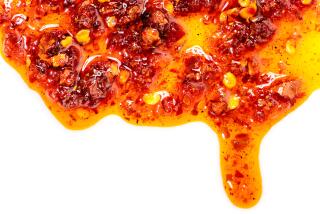Food Firms Cling to Dual Identities in East and West
- Share via
The makers of the nation’s best-selling mayonnaise have a name for it. In fact, they have two.
Southern Californians know CPC International’s mayonnaise as the Best Foods brand. But to everyone who lives east of the Rocky Mountains, it’s Hellmann’s.
As transplanted Easterners often discover on their own, the mayonnaises are identical except in name. Even the advertising is the same, right down to the “bring out the best” jingle.
In an era when big national food companies spend billions to develop and promote single national identities for their products, CPC is one of a handful that insists on selling an identical item under different brand names in the East and West.
In the case of CPC and McCormick & Co., a Baltimore spice and flavoring processor, the separate brands got their start through corporate mergers that took place years ago. Another firm, Oakland-based Dreyer’s Grand Ice Cream, started a separate Eastern brand as the result of trademark dispute with a competitor.
Marketing executives with long-established brands say they continue the twin products despite increased advertising expenses because consumers recognize the names. To eliminate a brand could result in a loss of label-conscious customers and market share.
“The brands are so strong and so well-recognized by consumers that it just wouldn’t be wise to drop one of them,” says Donald Dick Jr., a vice president at McCormick & Co., which markets McCormick spices east of the Mississippi and Schilling spices to the west.
There are drawbacks to having two different brands. Separate television commercials have to made for each brand, for example. CPC, with $350 million in annual mayonnaise sales, says it saves on advertising costs by using virtually identical ads.
“We have to shoot the ads twice, once for Hellmann’s and once for Best Foods, but the cost is really minimal,” says Joan Dargery, mayonnaise product manager at CPC, based in Englewood Cliffs, N.J. The company, which makes half of the mayonnaise sold in the United States, is perhaps best known for its Skippy peanut butter.
McCormick, the world’s biggest spice processor with $250 million in spice and flavoring sales last year, runs national magazine advertisements that show both brands, Dick says. That’s because its nearly impossible to be certain that some McCormick ads wouldn’t appear in Schilling territory. “It’s the only way that really makes sense for us,” says Dick.
CPC tried a similar format a number of years ago. Those ads showed Hellmann’s and Best Foods jars side by side, with an accompanying recipe that told consumers to use “either Hellmann’s or Best Foods mayonnaise.” Dargery says the ads “looked like we were giving consumers permission to use any mayonnaise--and we don’t want them to do that.”
CPC inherited the twin mayonnaise brands when it acquired Best Foods in 1958. At the time, Best Foods was selling Best Foods mayonnaise on the West Coast and Hellmann’s, which got started in New York State in 1912, on the East Coast.
McCormick bought the San Francisco-based A. Schilling & Co. in 1947 and kept up the two brands ever since. The company says spices and flavorings are identical--most are imported and then shipped to either the eastern processing plant in Hunt Valley, Md., outside Baltimore, or the western facility in Salinas.
The spices are packed in jars and in red-and-white tins that are identical except for the names. For this reason, few consumers who migrate from one coast to another notice the difference, Dick says.
Diane McIntyre, a spokeswoman for Dreyer’s, says few consumers seem to notice the different names when they see Dreyer’s and its eastern brand, Edy’s. She says that after television star Tony Danza ate some Edy’s ice cream on a recent “Who’s the Boss” episode, California consumers called the company to say they saw Dreyer’s on TV.
“The brown-and-white tubs are identical,” says McIntyre. “They (television viewers) noticed the package. They didn’t notice the name.”
Dreyer’s started the Edy’s brand in 1981 when the company started marketing in the Midwest. Dairy industry giant Kraft objected at the time that the Dreyer’s name was too similar to its Breyers ice cream. “They had a trademark on the name and we didn’t,” says McIntyre.
So Dreyer’s named its eastern brand after Joseph Edy, who co-founded the company with William A. Dreyer in 1928.
So what name do these bicoastal food companies use when they market their goods overseas?
McCormick & Co. uses only the McCormick name abroad. But CPC divides the world at the Rockies--Asia gets Best Foods and Europe gets Hellmann’s. “Best is very big in Japan,” says Dargery.
More to Read
Inside the business of entertainment
The Wide Shot brings you news, analysis and insights on everything from streaming wars to production — and what it all means for the future.
You may occasionally receive promotional content from the Los Angeles Times.










